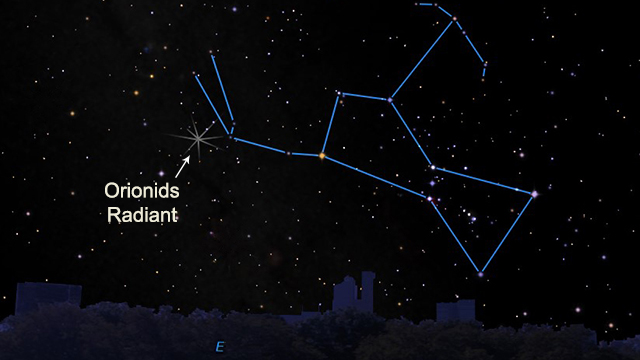The Orionid meteor shower peaks tonight! Here's how to see it.
It is recommended to view a dark sky for at least an hour to spot a shooting star.

The Orionid meteor shower peaks tonight into tomorrow morning (Oct. 20-21), and the moon will be dim enough that skygazers might be able to see one or several of these shooting stars.
The bright streaks across the sky that people may see from now until early November are bits and pieces from Halley's comet. Although the comet won't be visible from Earth again until about four decades from now, it leaves behind a debris path in the solar system. And each year during mid-October, the Earth passes through this field. Our planet also passes through another part of this debris field in early May, resulting in the Eta Aquarid meteor shower.
The Orionid meteors are known for their speed because they travel at about 148,000 mph (66 km/s) into the Earth's atmosphere, according to NASA. The meteor shower gets its name from its radiant, which is the point in the sky from which the streaks appear to emanate. The Orionid radiant is located near the constellation Orion, the hunter, next to the warrior's lifted arm.
Related: How to see the best meteor showers of 2020
The longer streaks appear away from the radiant, so the best way to view meteors is to either find a place to lay down flat on the ground for at least an hour or to look towards the part of the sky that is slightly higher than the location of the constellation Orion.
If possible, find a place that has little light pollution. Apps are great for locating constellations, but remember to avoid looking at a phone screen during meteor-shower viewing. It takes time for human eyes to adjust to the night sky, and a bright light could disrupt that eye training needed to spot dimmer meteors.
The moon will be a waxing crescent during the shower's peak, according to NASA, so the little moonlight coming off of that lunar sliver won't flood the sky during the meteor shower's peak. This makes it easier for viewers to spot shooting stars. Spectators can expect to see about 10-20 meteors an hour, according to Bill Cooke, the lead for NASA's Meteoroid Environment Office.
Breaking space news, the latest updates on rocket launches, skywatching events and more!
Follow Doris Elin Urrutia on Twitter @salazar_elin. Follow us on Twitter @Spacedotcom and on Facebook.

Doris is a science journalist and Space.com contributor. She received a B.A. in Sociology and Communications at Fordham University in New York City. Her first work was published in collaboration with London Mining Network, where her love of science writing was born. Her passion for astronomy started as a kid when she helped her sister build a model solar system in the Bronx. She got her first shot at astronomy writing as a Space.com editorial intern and continues to write about all things cosmic for the website. Doris has also written about microscopic plant life for Scientific American’s website and about whale calls for their print magazine. She has also written about ancient humans for Inverse, with stories ranging from how to recreate Pompeii’s cuisine to how to map the Polynesian expansion through genomics. She currently shares her home with two rabbits. Follow her on twitter at @salazar_elin.


